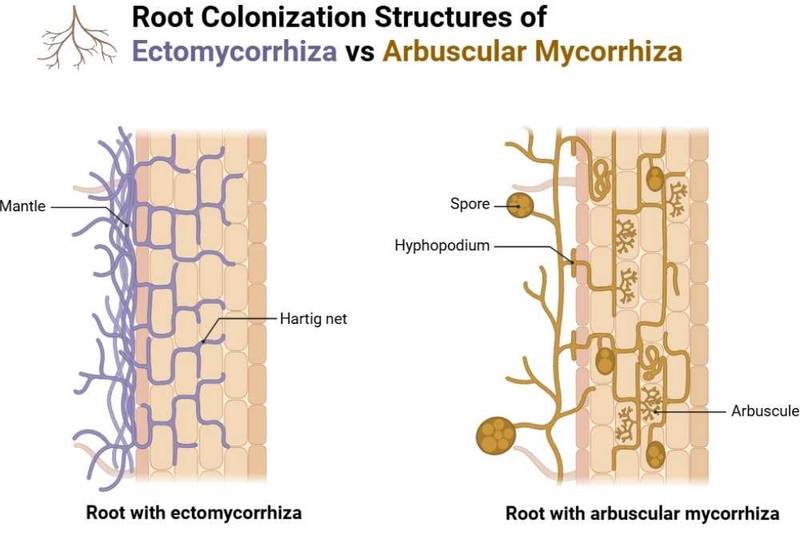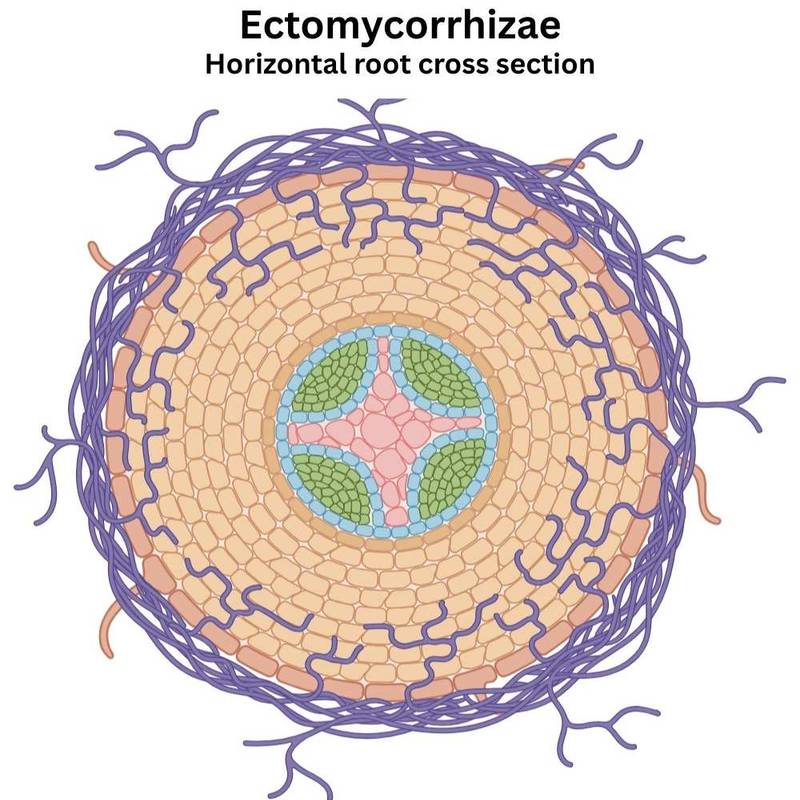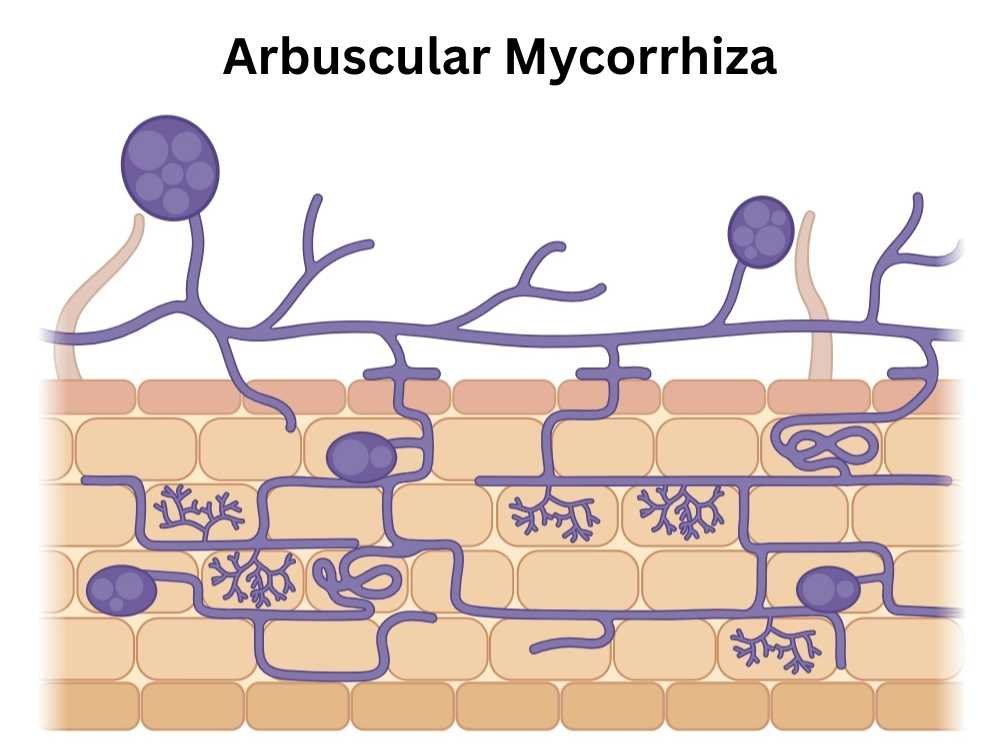Table of Contents
ToggleIntroduction
- The term mycorrhiza comes from the Greek words mykes (fungus) and rhiza (root), literally meaning “fungus root.”
- Mycorrhiza refers to the typically symbiotic association between a fungus and the roots of a plant. These fungi either live inside the root tissues or on the root surface, forming a unique biological partnership.
- In a healthy mycorrhizal association, the fungus aids the plant in absorbing water and essential nutrients—particularly phosphorus and nitrogen—while the plant supplies the fungus with carbohydrates produced during photosynthesis.
- This mutually beneficial relationship plays a vital role in plant physiology, nutrient cycling, soil health, and ecosystem stability.
- However, the relationship is not always perfectly mutualistic. In certain cases, the fungus may slightly harm the plant, or in rare instances, the plant may parasitize the fungus.
- It’s important to note that not all plants form mycorrhizal associations. In nutrient-rich soils, plants may grow well without fungal partners, and mycorrhizal fungi may not thrive under such conditions.
Types of Mycorrhiza
Mycorrhizae are generally classified based on the location of fungal colonization in plant roots. The two main categories are:
- Ectomycorrhizae
- Endomycorrhizae

1. Ectomycorrhizae
Ectomycorrhizae form a thick fungal sheath (mantle) around the root surface without penetrating plant cells. A specialized network of fungal hyphae, called the Hartig Net, extends between root cortical cells to facilitate nutrient exchange.
- Common Host Plants: Woody species such as birch (Betula), beech (Fagus), willow (Salix), pine (Pinus), oak (Quercus), spruce (Picea), and fir (Abies).
- Occurrence: Found in 5–10% of terrestrial plants, especially in forests.
- Function: Extends the root’s reach into the soil, improving water and mineral uptake, especially in nutrient-poor conditions.

2. Endomycorrhizae
- Endomycorrhizae, on the other hand, are present in more than 80% of currently living plant species, including greenhouse and agricultural plants like the majority of fruits, flowers, grasses, and vegetables.
- In endomycorrhizal interactions, the fungus penetrates the cortical cells and creates arbuscules and vesicles. To put it another way, endomycorrhiza have an exchange mechanism inside the root, and the hyphae of the fungus extend beyond the root.
- Compared to the ectomycorrhizal interaction, it is a more intrusive one.
Types of Endomycorrhiza
The particular kinds of endomycorrhiza are further categorized as follows:
- Orchidaceous Mycorrhizae
- Arbuscular Mycorrhizae
- Ericaceous Mycorrhizae
- Arbutoid Mycorrhizae
- Ectotrophic Mycorrhiza
1. Orchid Mycorrhiza
- As previously stated, certain orchids are unable to photosynthesize until they reach the seedling stage. The remaining orchids are completely non-photosynthetic.
- But every orchid relies on the sugars that its fungal partner gives it for at least a portion of its existence. Because orchid seeds cannot independently absorb enough nutrients to grow, they need fungal infection in order to germinate.
- The orchid parasitizes the fungus that infects its roots in this partnership.
- The hyphae of orchidaceous mycorrhiza penetrate the root’s cells and form hyphal coils, or pelotons, which serve as nutrient exchange sites, once the seed coat breaks and roots begin to emerge.
2. Arbuscular Mycorrhiza (AMF)
- The most common type of micorrhizae are arbuscular mycorrhizae, which are well-known for their particularly strong affinity for phosphorus and capacity for nutrient absorption.
- They create arbuscules, which are the locations of exchange for nutrients like phosphorus, carbon, and water.
- The fungi that participate in this mycorrhizal relationship belong to the zygomycota family and seem to be obligate symbionts. Simply put, the fungi cannot live without their host plant.

3. Ericaceous Mycorrhiza
- Plants of the order Ericales and those growing in harsh, acidic conditions are commonly associated with ericaceous mycorrhizae.
- Ericoid mycorrhiza does not produce arbuscules, although they do enter and invaginate the root cells.
- Nevertheless, they aid in controlling the plant’s absorption of minerals such as aluminum, manganese, and iron.
- Furthermore, mycorrhizal fungi produce hyphal coils outside of the root cells, which greatly increase the root’s volume.
4. Arbutoid Mycorrhiza
- Arbutoid mycorrhiza resembles ectomycorrhizal fungi in appearance and is a kind of endomycorrhizal fungus.
- Unlike ectomycorrhizal fungi, which create a fungal sheath around the plant’s roots, arbutoid mycorrhiza hyphae penetrate the plant root’s cortical cells.
5. Ectotrophic Mycorrhiza
- The fungi that participate in this mycorrhizal interaction belong to the Basidiomyota and Ascomyota families.
- They may be seen in a variety of trees in colder climates.
- In contrast to their wood-rotting relatives, these fungi obtain their sustenance and sugars from the roots of their live plant host and are not equipped to break down cellulose and other plant matter.
Examples of Mycorrhizal Plants
Ectomycorrhiza Examples:
- Pines: There are several types of pine trees, including the Scotch pine, that create ectomycorrhizal connections.
- Oak Trees: Oaks, such as the northern red oak, are frequently found to be in ectomycorrhizal symbiosis.
- Birch Trees: The majority of birch trees, like the silver birch, have ectomycorrhizal connections.
Arbuscular Mycorrhiza Examples:
- Grasses: Arbuscular mycorrhizal interactions are found in several grass species, such as wheat and maize.
- Legumes: Plants like peas and soybeans commonly form arbuscular mycorrhizal interactions.
- Sunflowers: The common sunflower is an example of a plant that can form arbuscular mycorrhizal connections.
Mycorrhizae: The Symbiotic Relationship between Fungi and Roots
- Low nutrient concentration, a sluggish diffusion rate, or insufficient soil moisture can cause a nutrient depletion zone to form when there is quick soil solution absorption. Because these circumstances are so prevalent, the majority of plants depend on fungi to aid in mineral absorption from the soil.
- Mycorrhizae sometimes referred to as root fungi; create symbiotic relationships with plant roots.
- The fungi are truly incorporated into the root’s physical makeup in these relationships.
- During active plant growth, the live root tissue is colonized by the fungus.
- The plant acquires phosphate and other minerals, such as zinc and copper, from the soil via mycorrhization.
- The plant root supplies the fungus with nutrients, such as sugars.
- Due to the fact that hyphae are tiny and may extend outside the nutrient depletion zone, mycorrhizae help enlarge the surface area of the plant root system.
- Hyphae are lengthy fungal extensions that have the potential to enter tiny soil pores, providing the plant with access to phosphorus that it would not have otherwise. The plant’s positive effect is most evident in bad soils.
- Fungi gain the advantage of being able to access up to 20% of the total carbon that plants utilize.
- The physical barrier to pathogens is provided by mycorrhizae.
- In addition, they cause an induction of widespread host defense mechanisms, which may include the synthesis of antibiotic chemicals by the fungi.
- Additionally, fungi have been shown to play a protective role for plants rooted in soils with high metal concentrations, such as acidic and polluted soils.
- Ectomycorrhizae and endomycorrhizae are the two main forms of mycorrhizae.
- The thick, dense covering that ectomycorrhizae create around the roots is known as the mantle.
- The mantle’s fungal hyphae protrude into the soil, expanding the surface area for nutrient and water absorption.
- Forest trees, notably conifers, birches, and oaks, have this kind of mycorrhizae.
- Endomycorrhizae, sometimes known as arbuscular mycorrhizae, do not form a thick covering over the root.
- Rather, the root tissue contains the fungal mycelium.
Plant Benefits from Mycorrhizae
- Mycorrhiza connections are especially helpful in places where the soil lacks enough nitrogen and phosphorus, as well as in regions where access to water is restricted.
- The mycorrhizal mycelia are far smaller and thinner than roots and root hairs, which greatly increase the surface area available for absorption of nitrogen, amino acids, phosphorus, and water much like a second set of roots.
- Plants that have mycorrhizal connections have an advantage over those that depend only on roots for nutrient absorption because these elements are crucial for plant development.
- Plants may be outcompeted without mycorrhiza, which may result in a shift in the area’s plant makeup.
- In addition, research has shown that plants with mycorrhizal associations are more resistant to specific diseases that are transmitted through the soil. As a matter of fact, mycorrhizal fungi might be a useful strategy for managing diseases.
- They form a physical barrier between plant roots and pathogens in the instance of sheathing mycorrhiza.
- Mycorrhiza also compete with pathogens for the absorption of vital nutrients, thicken the root’s cell walls through lignifications and the synthesis of additional carbohydrates, encourage the production of metabolites that boost disease resistance, promote flavonolic wall infusions that protect against lesion development and pathogen invasion, and raise the concentration of orthodihydorxy phenol and other allochemicals in plant roots to prevent pathogenic activity.
- Mycorrhizal fungi can also confer to its host plant resistance to toxicity and resistance to insects, in addition to disease resistance, which ultimately enhances the health and fitness of the plant.
- Mycorrhizal fungi can link individual plants within a mycorrhizal network in more complex interactions. The purpose of this network is to convey substances like water, carbon, and other nutrients from plant to plant, and it even offers a form of defense communication through chemicals that indicate an assault on a member of the network.
- In addition to using these signals to initiate the creation of organic insect repellents, plants can also use them to induce the production of an attractant that attracts the natural enemies of the pests that attack the plant!
- Certain plants, like trees in dystrophic forests, can avoid the requirement for soil absorption thanks to mycorrhizal fungi. Through mycorrhizal hyphae, phosphates and other nutrients are absorbed directly from the leaf litter.
- Mycorrhizal fungi are also able to modify the environment in ways that benefit the host plants, such as by enhancing soil structure and quality.
- Mycorrhizal fungi filaments produce humic substances, polysaccharides, and glycoproteins that bind soils, improve soil porosity, and facilitate the movement of air and water into the soil.
- Better soil structure can be more crucial to plant survival than nutrient absorption in areas with extremely sandy or compacted soils.
- Some ectomycorrhizal symbioses form structures that support nitrogen-fixing bacteria, which would significantly aid plants in absorbing nitrogen in nutrient-deprived conditions and would be a major component of the nitrogen cycle. But the mycorrhizal fungi do not fix nitrogen on their own.
Significance of Mycorrhiza in Agriculture and Forestry
- The surface area of roots can be increased by mycorrhizae, which enhances a plant’s capacity to absorb water and nutrients from the soil.
- It lowers the need for irrigation and fertilizer.
- It gives the plant resistance to pests and drought.
- Plants can become more resistant to a variety of environmental challenges thanks to mycorrhizae.
- Mycorrhizae can aid in the development and upkeep of soil quality and structure. In addition to this, they have the ability to produce humic chemicals and organic adhesives that promote soil porosity and aggregate development.
- It can aid plants in establishing and surviving during seeding or transplanting.
- The links aid in soil carbon sequestration.
- The variety and stability of plant communities are enhanced by mycorrhizae.
Commercial Uses, Products and Costs
- Mycorrhizae are made for a variety of applications, such as landscaping, nurseries, orchards/vineyards, commercial producers, homeowners, and land restoration initiatives.
- Mycorrhizal fungi are widely employed in organic production as well. It’s worth mentioning that most soils already have mycorrhizae, so it might not be necessary to buy them.
- Since the majority of soilless media lack mycorrhizae, they may be included if planting in pots.
- Mycorrhizal fungi may be found as a concentrated solution, in granular form, or as a powder.
- Depending on the product and amount needed, the cost of items might range from a few dollars to hundreds of dollars.
- The type, quantity, and spore counts of the fungi used as well as the price vary.
- Companies like Plant Success, Bio Organics, Soil Moist, and ARBICO Organics sell mycorrhizal fungi online or at garden centers and nurseries.
Precautions for Effective Mycorrhizal Use
- The ideal temperature for storing products is between 40° and 140° F (Fahrenheit).
- High doses of zinc, nitrogen, and phosphorus will prevent mycorrhizal infection.
- The majority of items have a shelf life that ranges from months to several years.
- Mycorrhizae fungi are a kind of fungus, so fungicides should be avoided.
Conclusion
Mycorrhizal fungi are indispensable partners in plant growth, especially in nutrient-poor or water-scarce environments. By forming mutualistic symbioses with plant roots, they significantly enhance nutrient uptake, improve soil health, increase stress tolerance, and contribute to ecosystem stability.
In agriculture, forestry, and ecological restoration, mycorrhizal inoculation offers a sustainable alternative to chemical fertilizers, helping to boost productivity while preserving environmental balance. Harnessing the power of these microscopic allies is a key step toward a greener, more resilient future in plant science and soil management.
Frequently Asked Questions (FAQ) on Mycorrhizal Associations
Q1: What are mycorrhizae in plants?
Mycorrhizae are beneficial fungi that form a symbiotic relationship with plant roots, helping them absorb water and nutrients like phosphorus, while plants provide sugars to the fungi.
Q2: What are the types of mycorrhizal fungi?
The two main types are ectomycorrhizae, which grow around the root surface, and endomycorrhizae (arbuscular mycorrhizae), which grow inside root cells.
Q3: Do all plants need mycorrhizal fungi?
No. While over 80% of plants benefit from mycorrhizae, some plants in nutrient-rich soils can grow well without them.
Q4: How do mycorrhizal fungi help plants grow?
They improve nutrient and water absorption, increase drought tolerance, protect roots from pathogens, and enhance soil structure.
Q5: Can farmers use mycorrhizae in agriculture?
Yes. Mycorrhizal inoculants can boost crop yields, reduce fertilizer use, and improve plant resilience to environmental stress.
Q6: Which crops benefit most from mycorrhizal fungi?
Common examples include wheat, maize, peas, soybeans, and sunflowers.
Q7: How can you increase mycorrhiza in soil naturally?
Reduce chemical fertilizers, avoid fungicides, plant diverse species, and minimize deep tillage to support natural mycorrhizal populations.
Q8: Are mycorrhizal fungi the same as nitrogen-fixing bacteria?
No. Mycorrhizae absorb nutrients from the soil, while nitrogen-fixing bacteria convert atmospheric nitrogen into usable forms for plants.
Also Read
- Rhizobium: The Nitrogen-Fixing Bacterium
- Bacillus subtilis– Morphology, Habitat, Diseases & Industrial Applications
- Basics of Food Microbiology in
- Top 10 Universities in India for Microbiology
- Immune System Cells: The Body’s Cellular Defenders
- Biochar: Properties, Production, and Applications
- Antimicrobial Resistance (AMR) Mechanisms and Alternatives
- Microbiology Notes
- Bacteriology Quiz
- Immunology Quiz

